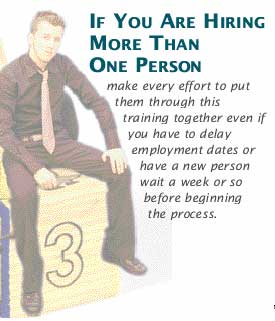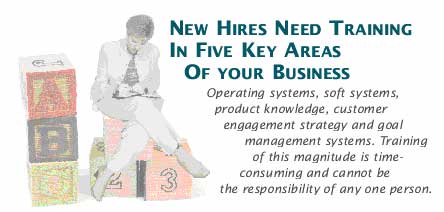Sales Management by Joe Capillo
A detailed orientation and training plan that cuts attrition rates and boosts early productivity.
Editor’s Note: Editor’s Note: This article completes Joe Capillo’s three part series on sales staffing with a detailed discussion of training and orientation procedures. Taken together, these articles provide a template that retail managers can follow to design and implement sales staffing programs. Calculating staffing requirements, finding the right people and interviewing them were discussed in the October/November and December/January issues. These previous articles can be found in the “sales management article index” on FURNITURE WORLD
Magazine’s website www.furninfo.com.
New Hire Support
Getting started as a new salesperson in our business is a slow process. Most companies pay commissions on delivered sales so there is a built-in lag between performance and compensation. Building a backlog of undelivered orders to support commissions can take several months for the best new people.
Training and orientation should be given more time and attention than is usually allowed in most stores. Putting a new, inexperienced and untrained salesperson in front of your valued customers can have disastrous consequences for everyone.
Allow one full month for training and orientation before turning a new person loose on the floor. Even then, a three-month term of added support and continued training should be part of a new hire development plan. You can cut this short anytime you and your team agree that a person is ready for solo flight. Experience shows that this method of bringing new people into the company ensures lower attrition rates during the first year, when most new people fail, and results in more early productivity than any other method.
Training New Hires
Newly hired salespeople need training in five key areas of your business:
1. Operating systems
2. Soft systems such as those for human resources, sales administration, customer service, delivery and credit.
3. Product knowledge for all categories with special attention paid to high-profit areas such as fabric treatment and warranties.
4. Your selling system or customer engagement strategy. This will include the management system.
5. Your goal management system, or how to make money in your store. This includes a complete explanation of all sales performance expectations or minimum standards.

Training of this magnitude is time-consuming and cannot be the total responsibility of any one person. Your entire management and sales staff should be enlisted as instructors so that each individual will only need to dedicate a short period of their time to training, thereby ensuring that it will actually get done. An added benefit of this approach is that every new hire will be surrounded by and infused with a feeling of teamwork and professionalism.
Your sales manager will act as the training coordinator and part-time trainer for this course which we suggest be spread over three to four weeks including time for “shadow training” on the floor.
If you are hiring more than one person, make every effort to put them through this training together even if you have to delay employment dates or have a new person wait a week or so before beginning the process. Group training is more interactive for both the trainer and the trainees and there is a lot of fun work new hires can perform as a team.
A Sample Plan
Day One - Morning Session: Conducted by HR Manager or owner/store manager/sales manager.
- HR orientation, necessary employment forms, benefits review.
- Company organization chart, chain of communications, policies, rules & regulations.
- Person-to-person introductions.
Day One - Afternoon: Department heads.
- Departmental review, workflow descriptions.
Day Two - Morning: Department heads.
- Continue departmental review - workflow descriptions.
Day Two - Afternoon: Sales manager.
- Introduction to computer system.
- Introduction to metrics gathering system.
Day Three - Morning: Operations manager.
•Warehouse operations.
•Work in warehouse -delivery preparation, etc.
Day Three - Afternoon: Operations manager.
Day Four - Morning: Operations manager
Day Four - Afternoon: Operations manager.
- Follow the truck
- Truck check-in processes
- Review all end-of-day processes
Day Five - Morning: Sales manager or merchandise manager
- Introduction to floor merchandise.
- Vendor review.
- Category review.
Day Five - Afternoon: New hires.
- First category floor audit.
Day Six - Morning: Sales manager merchandise manager or assigned salesperson.
- Category review - one hour.
- Category audit continues.
- Introduction to selling system.
Day Seven - Morning: Sales manager or assigned salesperson or office person.
Day Seven - Afternoon: New hire.
- Product category audit continues.
Day Eight - Morning: Sales manager or assigned salesperson or office person.
Day Eight - Afternoon: Sales manager, merchandise manager or assigned salesperson.
- Final product/category review.
- Special order training.
Day Nine - Morning: Sales manager.
Day Nine - Afternoon:
- Selling system training.
- Day Ten - Morning Session: Sales manager-Reps.
- Product reviews.
Day Ten - Afternoon: Sales manager - Reps.
Days Eleven Through Thirteen:
- To be spent on the floor in shadow training with an experienced salesperson to learn what it's like at the point of contact without being responsible for anything happening. Work with and assist salesperson in all aspects of the job.

Day Fourteen:
Day Fifteen:
- Open for review of all aspects of the training.
- Testing.
- Critique from both sides.
- Performance review with shadow trainer and sales manager.
The above schedule should be adjusted to your store's organization and structure and to the limitations of your staff. It is important to develop a written format and agenda for all new hire training to ensure that the job gets done completely and correctly.
Allow each of the department heads who will make up the “faculty” for this training program to develop their own departmental agendas. They know the actions, errors and omissions made by current salespeople, that positively or negatively impact the customer experience in your store. The sales manager will make the final decisions on what goes into new hire training for salespeople.
Shadow Training
Building a high-performance team consisting of all the people in your organization requires that each employee knows his or her own job thoroughly. They must also be willing to assist others to attain mastery of these processes so as to provide everyone with a better understanding of how the company works. This is why all members of your company should be involved in the training and development of new employees. The kind of training program outlined above for salespeople, can be used by any department to help new people become more effective early in their careers.
Sales positions are different than other jobs because of the unique nature of interpersonal relationships. Salespeople are the highest paid employees exactly because we recognize how hard the job is when done correctly.
Shadow training is an important idea for one important reason:
It allows a newly hired salesperson to experience the dynamic nature of face-to-face consumer interaction as an observer without being accountable for the outcome. The new hire “shadows” an experienced person who introduces them to the customer as a new member of the sales team. They listen and absorb, but do not participate in the sale except as requested by the trainer.
If your experienced salespeople are properly performing their duties - according to your selling system - then shadow training will allow trainees to see how the things they've learned in the classroom manifest in real world selling.
Assigned shadow trainers are your best salespeople - the ones who sell according to established store policies and procedures. A benefit of the shadow training system is that in trying to do their job well, the trainer will raise their own level of compliance with the principles of your selling system, so you get a double benefit.
Compensating Shadow Trainers
You should consider compensating your shadow trainers in some way to make the effort worthwhile and elevate the importance of this task. Doing so will help to overcome some of the resentment sales people sometimes exhibit toward the newly hired, because only your best, most effective people will qualify to be shadow trainers.
Compensation methods can be as simple as straight-up extra pay for the week of training with an additional bonus paid when the new hire achieves his or her monthly goal for the first time. Your compensation system will depend on your store's unique circumstances, but you should consider making the role of the shadow trainer an important one so that all salespeople will strive to participate.
We've combined the functions of staffing and new hire training into this three-part series of articles (that began with the October/November and the December/January issues of FURNITURE WORLD) to emphasize our position that the two are inextricably linked, and that new hire training should be an integral part of the hiring process. Copies of the first two articles can be found in the “operations management article” index on www.furninfo.com.